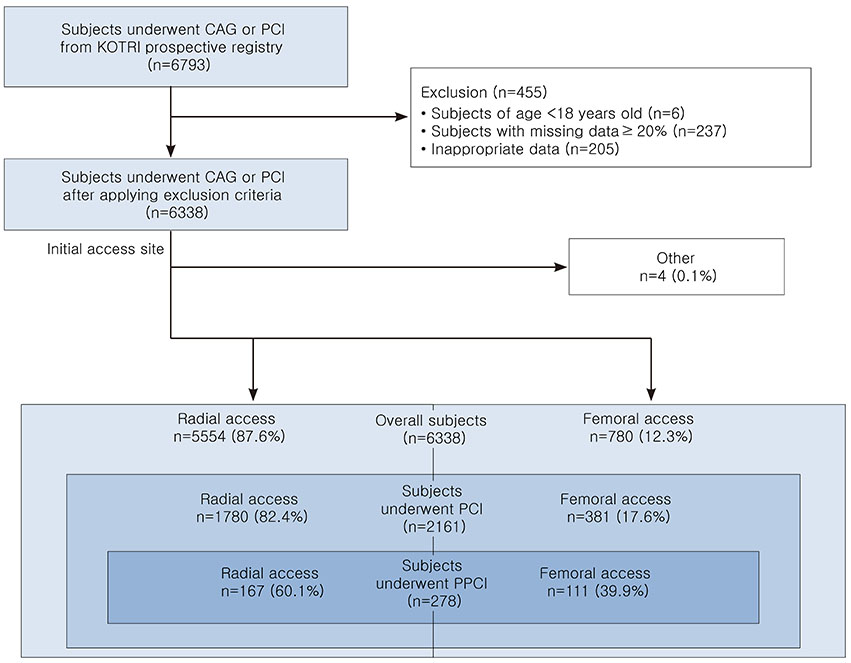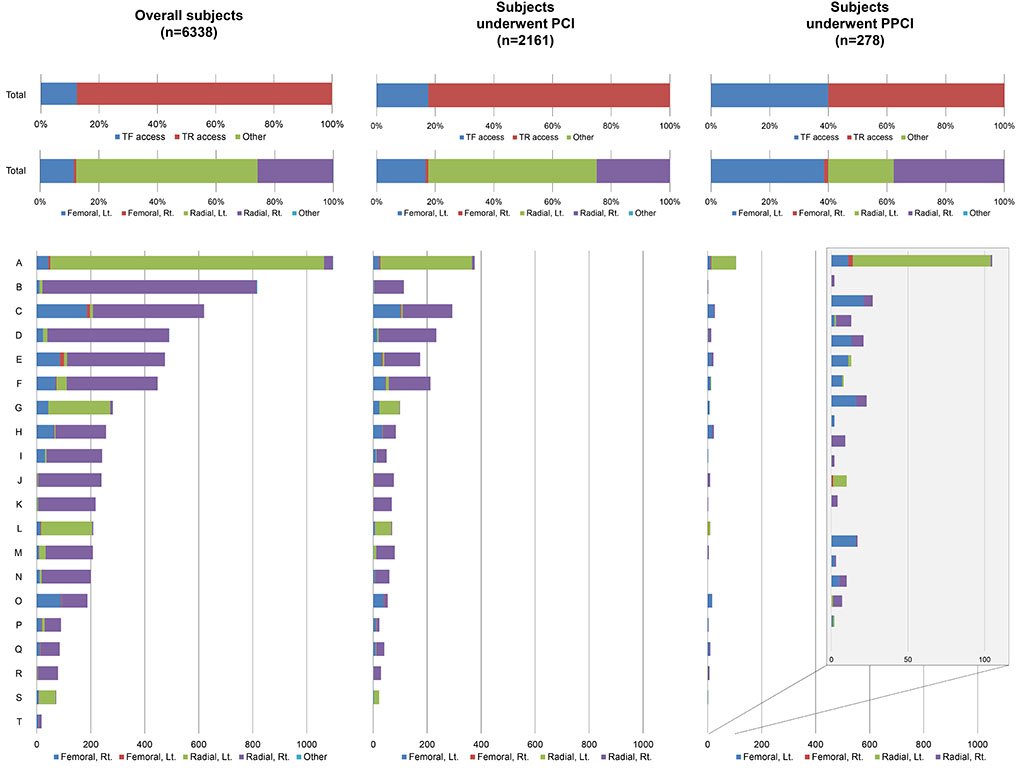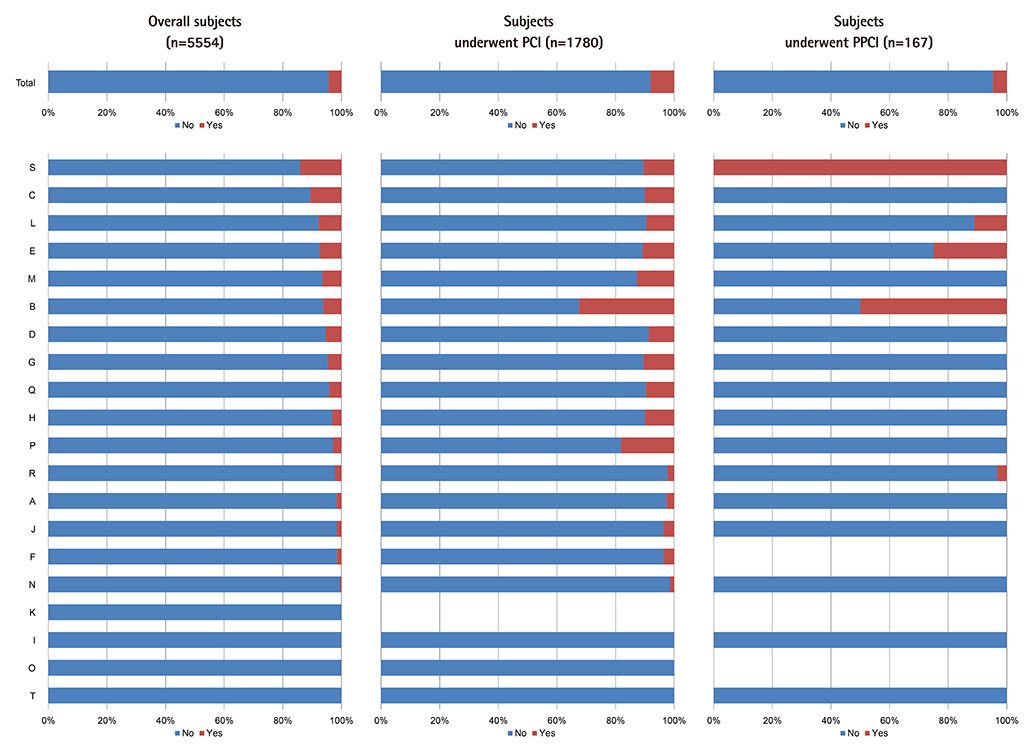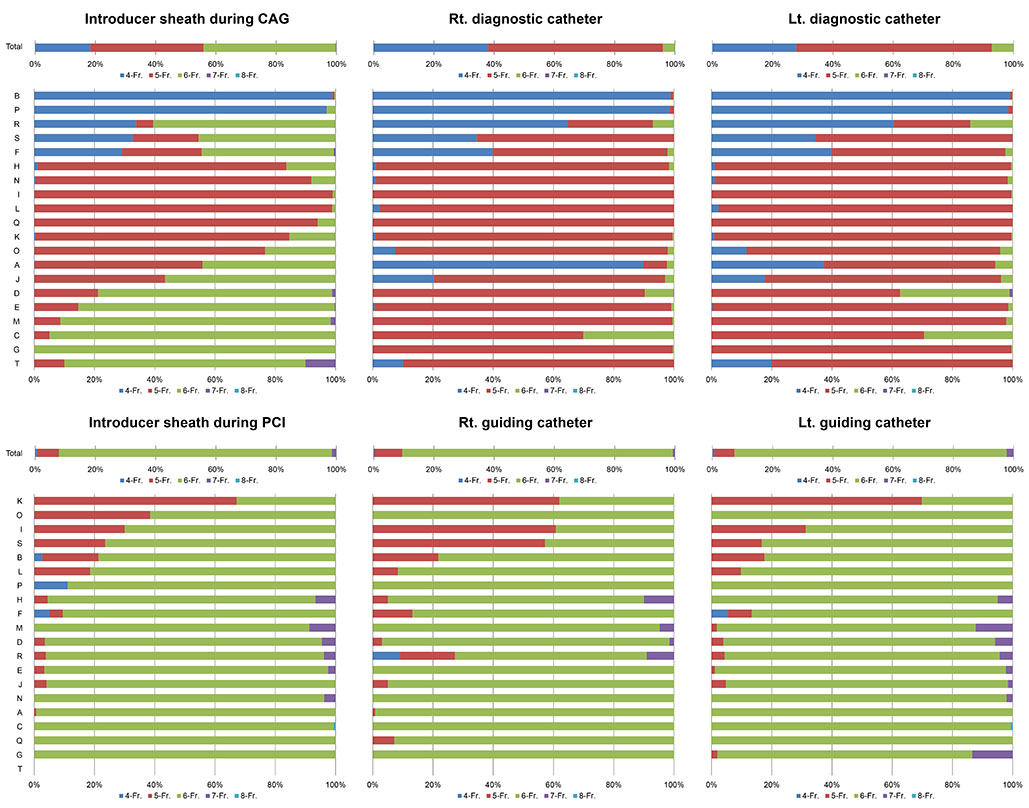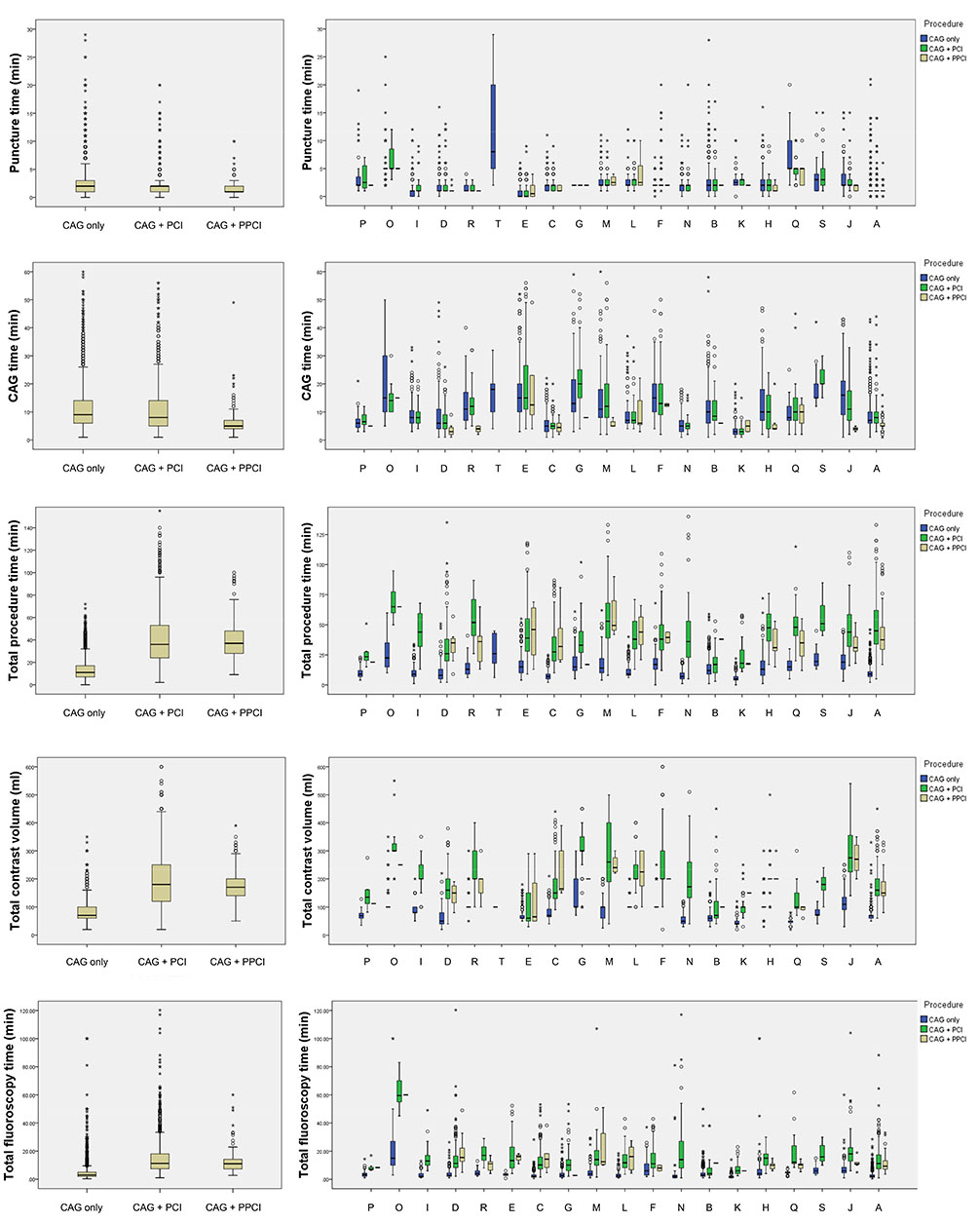Korean Circ J.
2015 Nov;45(6):457-468. 10.4070/kcj.2015.45.6.457.
Current Practice of Transradial Coronary Angiography and Intervention: Results from the Korean Transradial Intervention Prospective Registry
- Affiliations
-
- 1Wonju Severance Christian Hospital, Wonju, Korea. jyoon@yonsei.ac.kr
- 2Kangwon National University Hospital, Chuncheon, Korea.
- 3Ulsan University Gangneung Asan Hospital, Gangneung, Korea.
- 4Catholic University Bucheon St. Mary's Hospital, Bucheon, Korea.
- 5Chungnam National University Hospital, Daejeon, Korea.
- 6Konyang University Hospital, Daejeon, Korea.
- 7Daegu Catholic University Medical Center, Daegu, Korea.
- 8Soonchunhyang University Bucheon Hospital, Bucheon, Korea.
- 9Inha University Hospital, Incheon, Korea.
- 10Hallym University Kandgong Sacred Heart Hospital, Seoul, Korea.
- 11Chonnam National University Hospital, Gwangju, Korea.
- 12Korea University Guro Hospital, Seoul, Korea.
- 13Catholic University Daejeon St. Mary's Hospital, Daejeon, Korea.
- 14Kwandong University Myongi Hospital, Goyang, Korea.
- 15Chung-Ang University Hospital, Seoul, Korea.
- KMID: 2223783
- DOI: http://doi.org/10.4070/kcj.2015.45.6.457
Abstract
- BACKGROUND AND OBJECTIVES
Although increasing evidence has indicated that radial access is a beneficial technique, few studies have focused on Korean subjects. The aim of this study was to evaluate current practice of coronary angiography (CAG) and percutaneous coronary intervention (PCI) using radial access in South Korea.
SUBJECTS AND METHODS
A total of 6338 subjects were analyzed from Korean Transradial Intervention prospective registry that was conducted at 20 centers in Korea. After evaluating the initial access, subjects intended for radial access were assessed for their baseline, procedure-related, and complication data. Subjects were categorized into three groups: group of overall subjects (n=5554); group of subjects who underwent PCI (n=1780); and group of subjects who underwent primary percutaneous coronary intervention (PPCI) (n=167).
RESULTS
The rate of radial artery as an initial access and the rate of access site crossover was 87.6% and 4.4%, respectively, in overall subjects. Those rates were 82.4% and 8.1%, respectively, in subjects who underwent PCI, and 60.1% and 4.8%, respectively, in subjects who underwent PPCI. For subjects who underwent CAG, a 6-F introducer sheath and a 5-F angiographic catheter was the most commonly used. During PCI, a 6-F introducer sheath (90.6%) and a 6-F guiding catheter were standardly used.
CONCLUSION
The large prospective registry allowed us to present the current practice of CAG and PCI using radial access. These data provides evidence to achieve consensus on radial access in CAG and PCI in the Korean population.
MeSH Terms
Figure
Cited by 1 articles
-
Diagnosis and management of acute coronary syndrome
Doo Soo Jeon
J Korean Med Assoc. 2017;60(7):568-576. doi: 10.5124/jkma.2017.60.7.568.
Reference
-
1. Mamas MA, Ratib K, Routledge H, et al. Influence of access site selection on PCI-related adverse events in patients with STEMI: meta-analysis of randomised controlled trials. Heart. 2012; 98:303–311.2. Authors/Task Force members. Windecker S, Kolh P, et al. 2014 ESC/EACTS Guidelines on myocardial revascularization: the Task Force on Myocardial Revascularization of the European Society of Cardiology (ESC) and the European Association for Cardio-Thoracic Surgery (EACTS) developed with the special contribution of the European Association of Percutaneous Cardiovascular Interventions (EAPCI). Eur Heart J. 2014; 35:2541–2619.3. Levine GN, Bates ER, Blankenship JC, et al. 2011 ACCF/AHA/SCAI Guideline for Percutaneous Coronary Intervention. A report of the American College of Cardiology Foundation/American Heart Association Task Force on Practice Guidelines and the Society for Cardiovascular Angiography and Interventions. J Am Coll Cardiol. 2011; 58:e44–e122.4. Ball WT, Sharieff W, Jolly SS, et al. Characterization of operator learning curve for transradial coronary interventions. Circ Cardiovasc Interv. 2011; 4:336–341.5. Mehran R, Rao SV, Bhatt DL, et al. Standardized bleeding definitions for cardiovascular clinical trials: a consensus report from the Bleeding Academic Research Consortium. Circulation. 2011; 123:2736–2747.6. Agostoni P, Biondi-Zoccai GG, de Benedictis ML, et al. Radial versus femoral approach for percutaneous coronary diagnostic and interventional procedures; systematic overview and meta-analysis of randomized trials. J Am Coll Cardiol. 2004; 44:349–356.7. Pristipino C, Pelliccia F, Granatelli A, et al. Comparison of access-related bleeding complications in women versus men undergoing percutaneous coronary catheterization using the radial versus femoral artery. Am J Cardiol. 2007; 99:1216–1221.8. Vink MA, Amoroso G, Dirksen MT, et al. Routine use of the transradial approach in primary percutaneous coronary intervention: procedural aspects and outcomes in 2209 patients treated in a single high-volume centre. Heart. 2011; 97:1938–1942.9. Burzotta F, Trani C, Mazzari MA, et al. Vascular complications and access crossover in 10,676 transradial percutaneous coronary procedures. Am Heart J. 2012; 163:230–238.10. Jolly SS, Yusuf S, Cairns J, et al. Radial versus femoral access for coronary angiography and intervention in patients with acute coronary syndromes (RIVAL): a randomised, parallel group, multicentre trial. Lancet. 2011; 377:1409–1420.11. Pristipino C, Roncella A, Trani C, et al. Identifying factors that predict the choice and success rate of radial artery catheterisation in contemporary real world cardiology practice: a sub-analysis of the PREVAIL study data. EuroIntervention. 2010; 6:240–246.12. Dehghani P, Mohammad A, Bajaj R, et al. Mechanism and predictors of failed transradial approach for percutaneous coronary interventions. JACC Cardiovasc Interv. 2009; 2:1057–1064.13. Saito S, Ikei H, Hosokawa G, Tanaka S. Influence of the ratio between radial artery inner diameter and sheath outer diameter on radial artery flow after transradial coronary intervention. Catheter Cardiovasc Interv. 1999; 46:173–178.14. Spaulding C, Lefèvre T, Funck F, et al. Left radial approach for coronary angiography: results of a prospective study. Cathet Cardiovasc Diagn. 1996; 39:365–370.15. Stella PR, Kiemeneij F, Laarman GJ, Odekerken D, Slagboom T, van der Wieken R. Incidence and outcome of radial artery occlusion following transradial artery coronary angioplasty. Cathet Cardiovasc Diagn. 1997; 40:156–158.16. Sanmartin M, Gomez M, Rumoroso JR, et al. Interruption of blood flow during compression and radial artery occlusion after transradial catheterization. Catheter Cardiovasc Interv. 2007; 70:185–189.17. Steffenino G, Fabrizi Mde B, Baralis G, et al. Implementation of radial arterial access for cardiac interventions: a strong case for quality assurance protocols by the nursing staff. J Cardiovasc Med (Hagerstown). 2011; 12:116–121.18. Jolly SS, Amlani S, Hamon M, Yusuf S, Mehta SR. Radial versus femoral access for coronary angiography or intervention and the impact on major bleeding and ischemic events: a systematic review and meta-analysis of randomized trials. Am Heart J. 2009; 157:132–140.19. Montalescot G, Ongen Z, Guindy R, et al. Predictors of outcome in patients undergoing PCI. Results of the RIVIERA study. Int J Cardiol. 2008; 129:379–387.20. Chase AJ, Fretz EB, Warburton WP, et al. Association of the arterial access site at angioplasty with transfusion and mortality: the M.O.R.T.A.L study (Mortality benefit Of Reduced Transfusion after percutaneous coronary intervention via the Arm or Leg). Heart. 2008; 94:1019–1025.21. Rao SV, Ou FS, Wang TY, et al. Trends in the prevalence and outcomes of radial and femoral approaches to percutaneous coronary intervention: a report from the National Cardiovascular Data Registry. JACC Cardiovasc Interv. 2008; 1:379–386.22. Verheugt FW, Steinhubl SR, Hamon M, et al. Incidence, prognostic impact, and influence of antithrombotic therapy on access and nonaccess site bleeding in percutaneous coronary intervention. JACC Cardiovasc Interv. 2011; 4:191–197.23. Karrowni W, Vyas A, Giacomino B, et al. Radial versus femoral access for primary percutaneous interventions in ST-segment elevation myocardial infarction patients: a meta-analysis of randomized controlled trials. JACC Cardiovasc Interv. 2013; 6:814–823.24. Hamon M, Pristipino C, Di Mario C, et al. Consensus document on the radial approach in percutaneous cardiovascular interventions: position paper by the European Association of Percutaneous Cardiovascular Interventions and Working Groups on Acute Cardiac Care** and Thrombosis of the European Society of Cardiology. EuroIntervention. 2013; 8:1242–1251.25. Dahm JB, Vogelgesang D, Hummel A, Staudt A, Völzke H, Felix SB. A randomized trial of 5 vs. 6 French transradial percutaneous coronary interventions. Catheter Cardiovasc Interv. 2002; 57:172–176.26. Takeshita S, Asano H, Hata T, et al. Comparison of frequency of radial artery occlusion after 4Fr versus 6Fr transradial coronary intervention (from the Novel Angioplasty USIng Coronary Accessor Trial). Am J Cardiol. 2014; 113:1986–1989.27. Mercuri M, Mehta S, Xie C, Valettas N, Velianou JL, Natarajan MK. Radial artery access as a predictor of increased radiation exposure during a diagnostic cardiac catheterization procedure. JACC Cardiovasc Interv. 2011; 4:347–352.28. Baklanov DV, Kaltenbach LA, Marso SP, et al. The prevalence and outcomes of transradial percutaneous coronary intervention for ST-segment elevation myocardial infarction: analysis from the National Cardiovascular Data Registry (2007 to 2011). J Am Coll Cardiol. 2013; 61:420–426.
- Full Text Links
- Actions
-
Cited
- CITED
-
- Close
- Share
- Similar articles
-
- Feasibility and Problems in Transradial Coronary Angiography and Intervention
- A Case of Sheathless Transradial Coronary Intervention for Complex Coronary Lesions with a Standard Guiding Catheter
- Percutaneous Transradial Approach for Coronary Angiography
- Forearm Compartment Syndrome after Transradial Percutaneous Coronary Artery Intervention
- Transradial Interventions in Coronary Artery Disease: Comparison with Transfemoral Interventions

